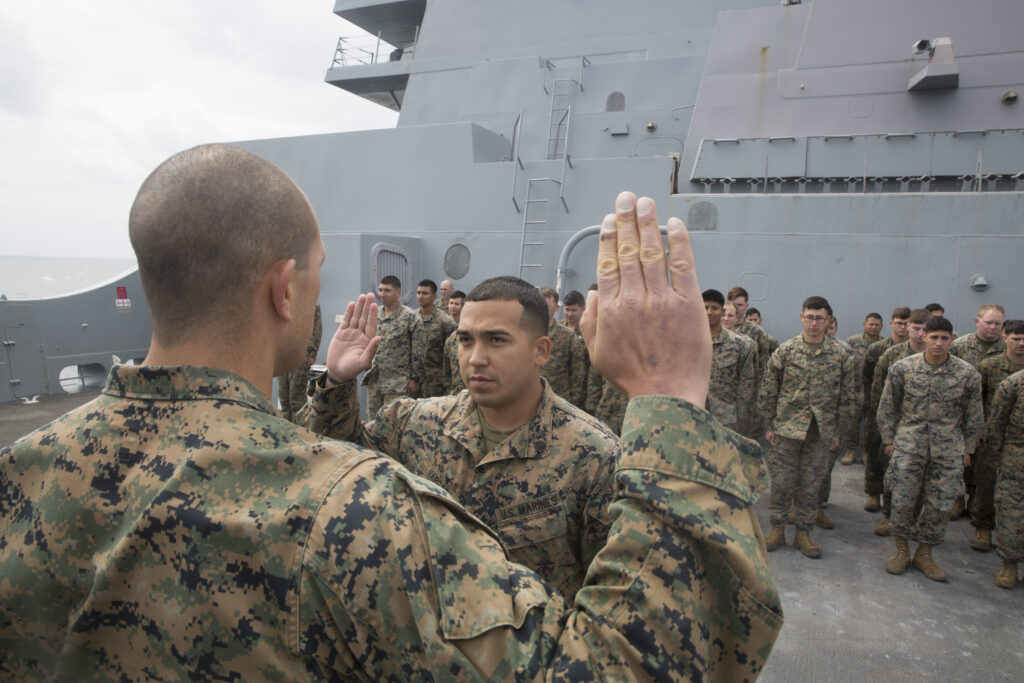
WASHINGTON — The U.S. Marine Corps is focusing on retention of serving Marines as a way to mitigate the challenges of recruiting in today’s American society, the Corps’ assistant commandant said in recent public forums.
“Our recruiting challenges this year across the board are, in fact, difficult, which is why we’re so focused on retention rather than recruiting,” said Gen. Eric Smith, assistant commandant of the Marine Corps, testifying July 19 before the House Armed Services Committee subcommittee on Readiness. “We will make or come very close to making our recruiting mission in ’22. It will come to a degree at the expense of the pool that we have ready for ’23. Any time you have less time in the delayed entry program, you will have a higher attrition rate at recruit training, which is unacceptable. So, the focus for us is retention, and then ensuring that the American people see the value proposition of service in the United States Marine Corps and the United States military writ large.”
Smith addressed the retention and recruiting challenge the day before during a July 18 webinar hosted by the Center for Strategic and International Studies and the U.S. Naval Institute and sponsored by HII.
“We cannot recruit our way out of our future challenges, but we can retain our way out,” he said. “If we have an individual who seeks to serve their nation, makes it through entry-level training, gets additional training, we want to keep that person. Why would I want them to go away, and them I have to go seek another person? That just adds to the problem. So, you can’t recruit your way out, but you can retain your way out.”
Smith, whose son currently serves as a Marine recruiter, discussed the value of the Marine brand.
“People say, ‘Other services are giving really big bonuses, $50,000 to $60,000; why aren’t you?’” he said. “Our biggest bonus we ever give — and we don’t give many to enlisted — is about $8,000, because the bonus is, you get to call yourself a U.S. Marine. And that’s not false bravado; it’s who we are, a brand; that’s who we recruit.
“What we do is we make sure that we are out there as a face,” Smith said. “71% of our enlistment contracts are [from] face-to-face contact from seeing a Marine with operational experience who is tough, tested, fit, ready to fight, who’s out there in the public square to engage with students. What I think we can do and need to do for students and those who’ve already graduated is work closely with the Department of Education, administrators and educators to really enforce the value proposition of service.”
The assistant commandant said the Corps needs to “counter the narrative that the Marine Corps service in general is not fulfilling. We’re a valuable thing and it’s a valuable service to the nation.”
He pointed out a streamlining of the re-enlistment process has taken place.
“A year ago, there were 22 steps to take to re-enlist,” he said. “That’s down to one. We use technology to streamline [re-enlistment]. If you wish to re-enlist and you’re a qualified Marine, the answer is yes.”
Smith said the Corps should ask a potential re-enlistee, “What would it take to keep you? It’s about managing talent as opposed to, ‘Here’s the cookie cutter.’”
He said the cookie cutter approach “will not work in the future environment where so many in our society are not qualified for enlistment or don’t wish to enlist.”
- Insitu Going Strong at 30, Focusing on Maritime Operations - April 8, 2024
- Navy Awards Boeing Additional Funds for MQ-25 Drones for Testing - April 3, 2024
- Benign 4th Fleet AOR Useful for Unmanned Vehicle Operationalization, Admiral Says - March 27, 2024






